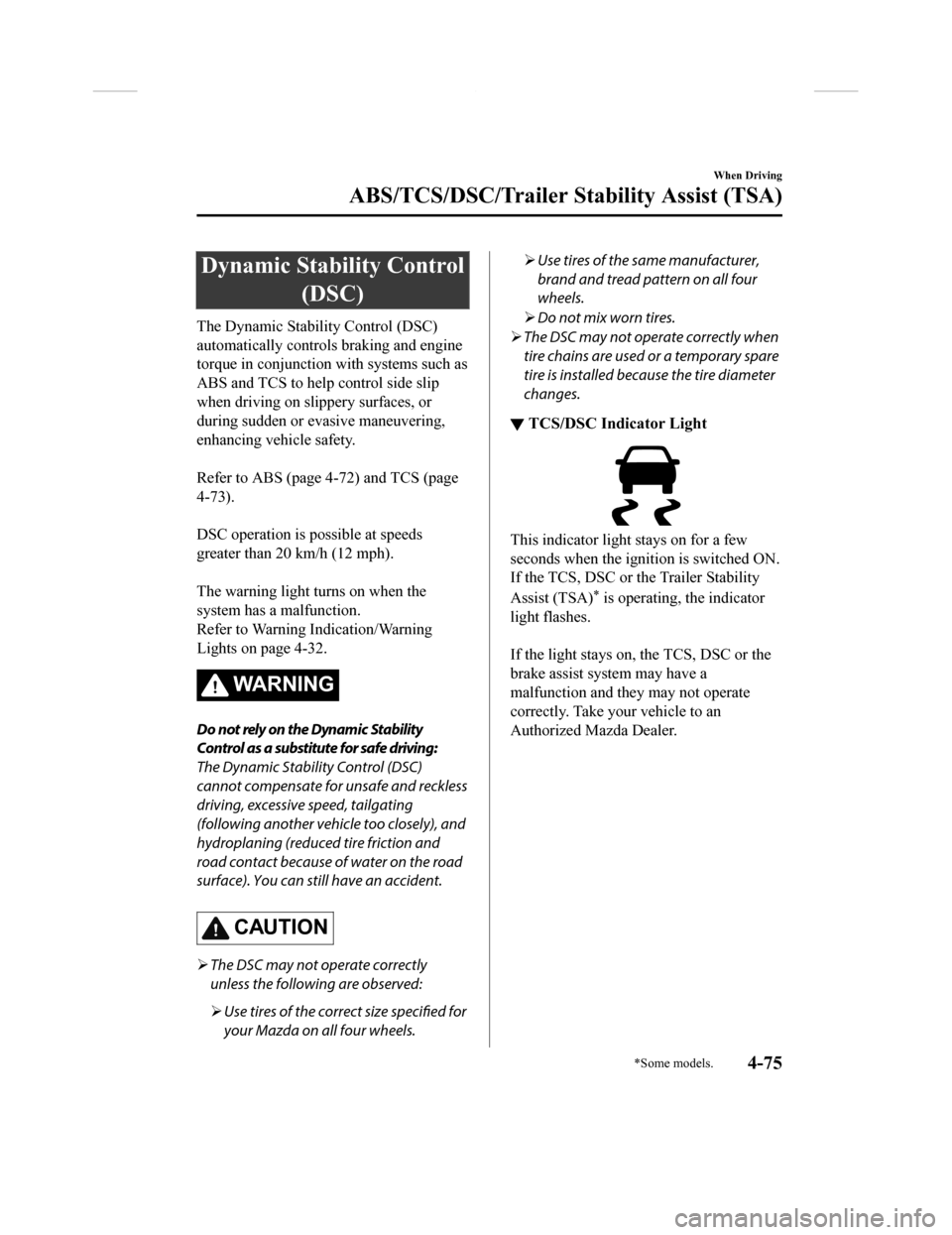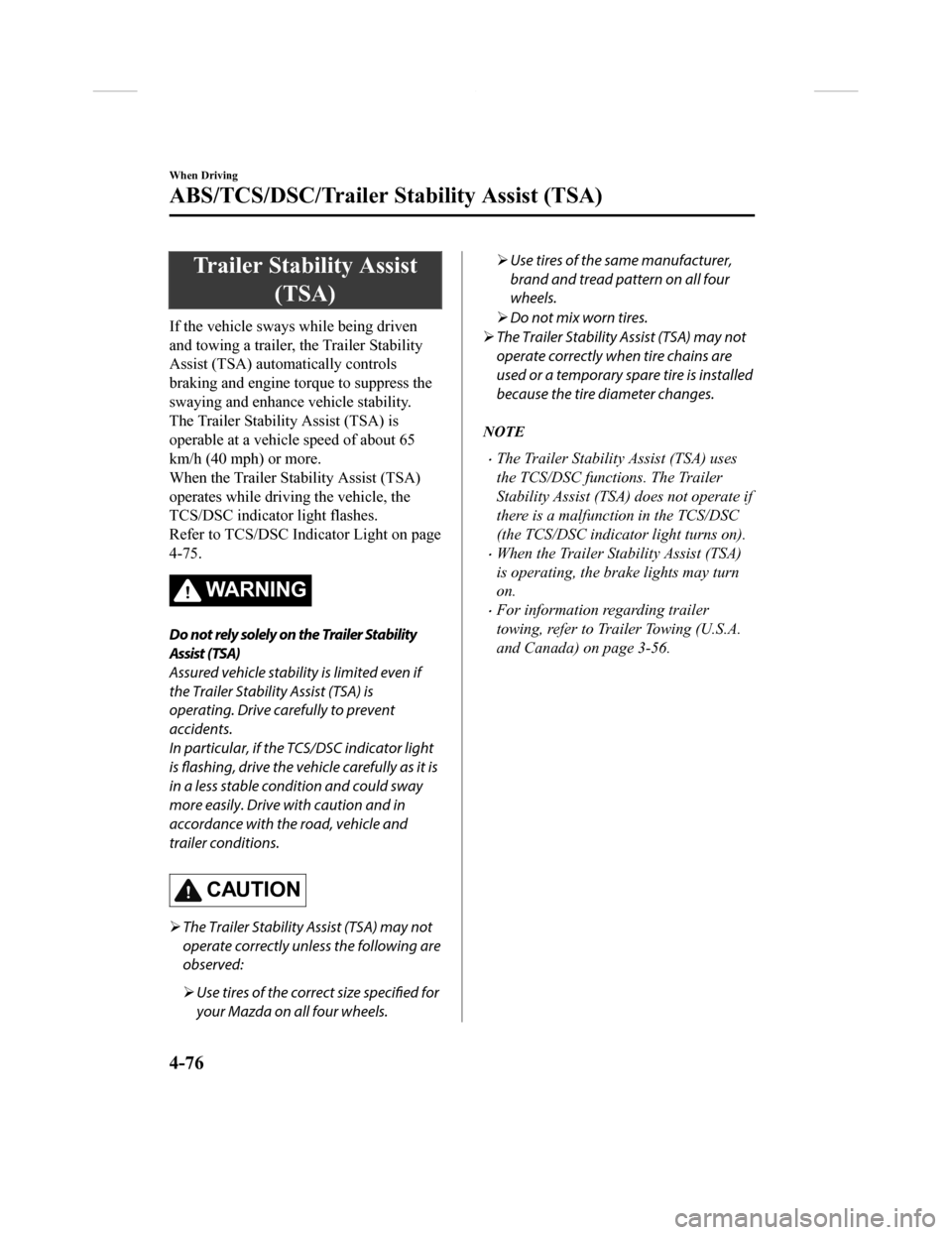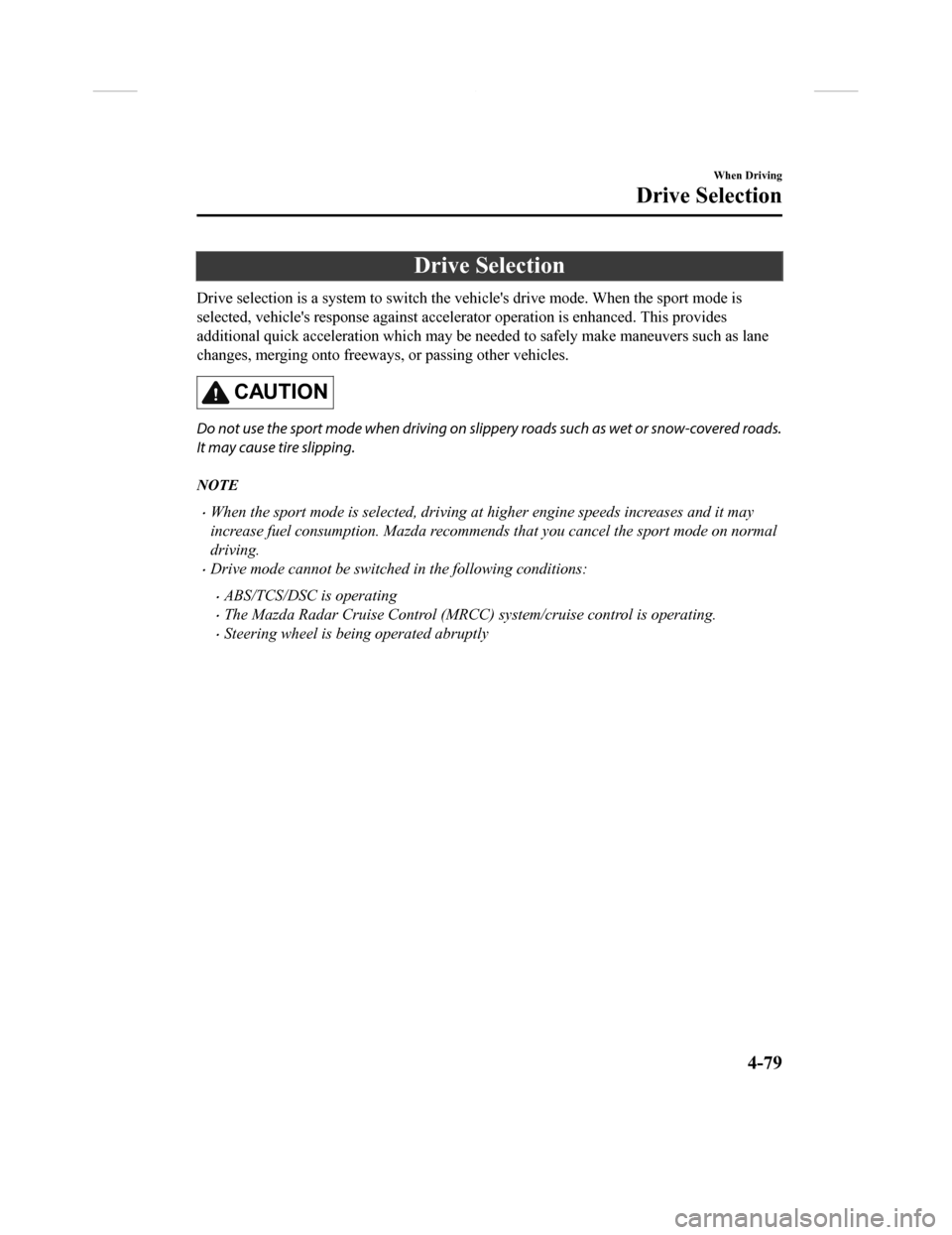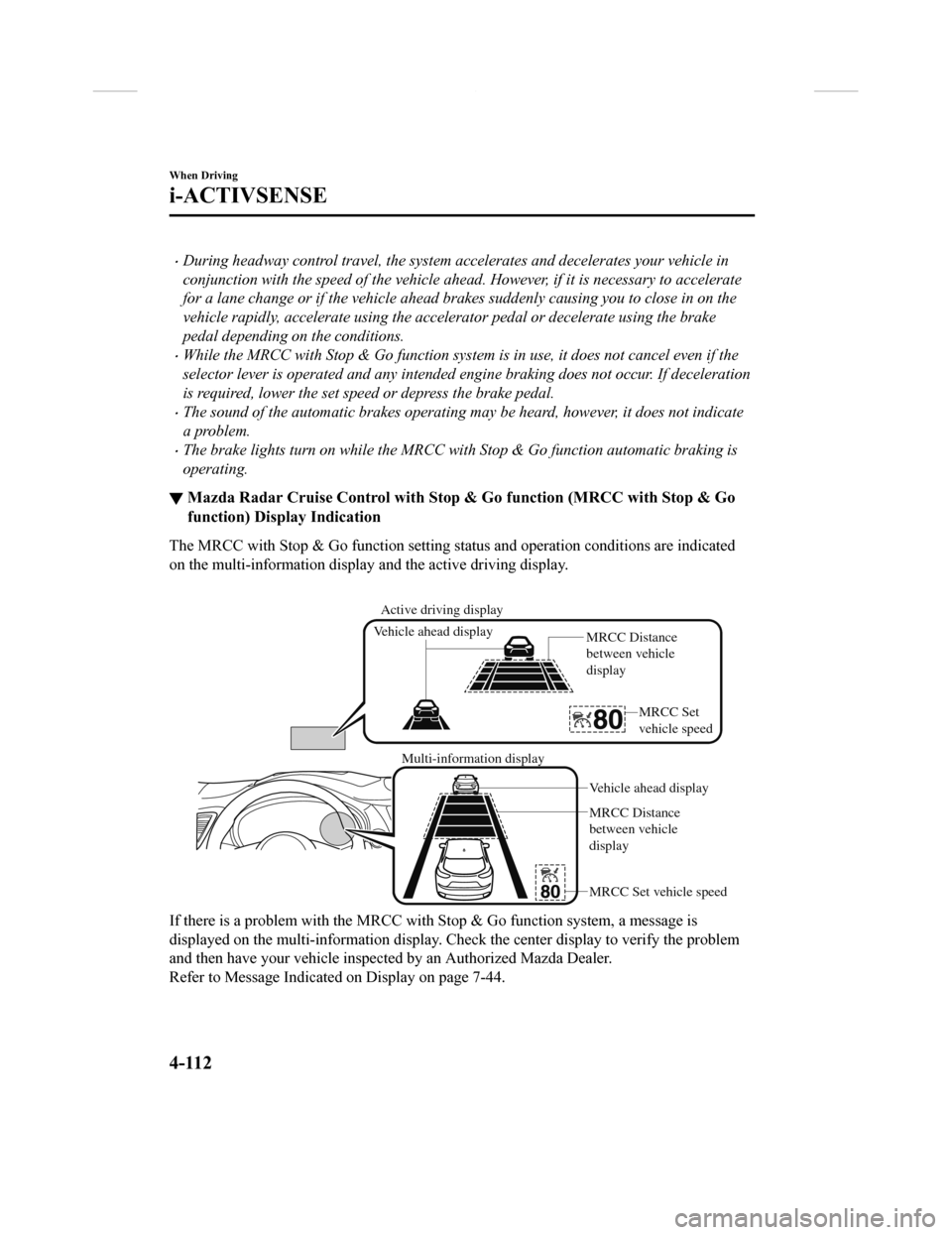eng MAZDA MODEL CX-9 2018 Owners Manual (in English)
[x] Cancel search | Manufacturer: MAZDA, Model Year: 2018, Model line: MODEL CX-9, Model: MAZDA MODEL CX-9 2018Pages: 640
Page 227 of 640

Traction Control System(TCS)
The Traction Control System (TCS)
enhances traction and safety by controlling
engine torque and braking. When the TCS
detects driving wheel slippage, it lowers
engine torque and operates the brakes to
prevent loss of traction.
This means that on a slick surface, the
engine adjusts automatically to provide
optimum power to the drive wheels,
limiting wheel spin and loss of traction.
The warning light turns on when the
system has a malfunction.
Refer to Warning Indication/Warning
Lights on page 4-32.
WA R N I N G
Do not rely on the Traction Control System
(TCS) as a substitute for safe driving:
The Traction Control System (TCS) cannot
compensate for unsafe and reckless
driving, excessive speed, tailgating
(following another vehicle too closely), and
hydroplaning (reduced tire friction and
road contact because of water on the road
surface). You can still have an accident.
Use snow tires or tire chains and drive at
reduced speeds when roads are covered
with ice and/or snow:
Driving without proper traction devices on
snow and/or ice-covered roads is
dangerous. The Traction Control System
(TCS) alone cannot provide adequate
traction and you co uld still have an
accident.
NOTE
To turn off the TCS, press the TCS OFF
switch (page 4-74).
▼ TCS/DSC Indicator Light
This indicator light stays on for a few
seconds when the ignition is switched ON.
If the TCS, DSC or the Trailer Stability
Assist (TSA)
* is operating, the indicator
light flashes.
If the light stays on, the TCS, DSC or the
brake assist system may have a
malfunction and they may not operate
correctly. Take your vehicle to an
Authorized Mazda Dealer.
NOTE
•In addition to the indicator light
flashing, a slight lugging sound will
come from the engine. This indicates
that the TCS/DSC is operating properly.
•On slippery surfaces, such as fresh
snow, it will be impossible to achieve
high rpm when the TCS is on.
When Driving
ABS/TCS/DSC/Trailer Stability Assist (TSA)
*Some models.4-73
CX-9_8GC3-EA-17G_Edition1 2017-5-29 10:13:38
Page 228 of 640

▼TCS OFF Indicator Light
This indicator light
stays on for a few
seconds when the ignition is switched ON.
It also illuminates when the TCS OFF
switch is pressed and TCS is switched off.
Refer to TCS OFF Switch on page 4-74.
If the light remains illuminated and the
TCS is not switched off, take your vehicle
to an Authorized Mazda Dealer. The DSC
may have a malfunction.
▼ TCS OFF Switch
Press the TCS OFF sw
itch to turn off the
TCS. The TCS OFF indicator light in the
instrument cluster and TCS OFF switch
indicator light turn on.
Indicator light
Press the switch agai n to turn the TCS
back on. The TCS OFF indicator light and
TCS OFF switch indica tor light will turn
off.
NOTE
•When TCS is on and you attempt to free
the vehicle when it is stuck, or drive it
out of freshly fallen snow, the TCS (part
of the DSC system) will activate.
Depressing the accelerator will not
increase engine power and freeing the
vehicle may be difficult. When this
happens, turn off the TCS.
•If the TCS is off when the engine is
turned off, it aut omatically activates
when the ignition is switched ON.
•Leaving the TCS on will provide the best
traction.
•If the TCS OFF switch is pressed and
held for 10 seconds or longer, the TCS
can no longer be turned off even if the
TCS OFF switch is pressed.
In this case, the TCS OFF switch will
operate normally when the ignition is
switched ON again after being switched
OFF.
When Driving
ABS/TCS/DSC/Trailer St ability Assist (TSA)
4-74
CX-9_8GC3-EA-17G_Edition1 2017-5-29 10:13:38
Page 229 of 640

Dynamic Stability Control(DSC)
The Dynamic Stability Control (DSC)
automatically controls braking and engine
torque in conjunction with systems such as
ABS and TCS to help control side slip
when driving on slippery surfaces, or
during sudden or evasive maneuvering,
enhancing vehicle safety.
Refer to ABS (page 4 -72) and TCS (page
4-73).
DSC operation is possible at speeds
greater than 20 km/h (12 mph).
The warning light turns on when the
system has a malfunction.
Refer to Warning Indication/Warning
Lights on page 4-32.
WA R N I N G
Do not rely on the Dynamic Stability
Control as a substitute for safe driving:
The Dynamic Stability Control (DSC)
cannot compensate for unsafe and reckless
driving, excessive speed, tailgating
(following another vehicle too closely), and
hydroplaning (reduced tire friction and
road contact because of water on the road
surface). You can still have an accident.
CAUTION
The DSC may not operate correctly
unless the following are observed:
Use tires of the correct size
specified for
your Mazda on all four wheels.
Use tires of the same manufacturer,
brand and tread pattern on all four
wheels.
Do not mix worn tires.
The DSC may not operate correctly when
tire chains are used or a temporary spare
tire is installed because the tire diameter
changes.
▼ TCS/DSC Indicator Light
This indicator light stays on for a few
seconds when the ignition is switched ON.
If the TCS, DSC or the Trailer Stability
Assist (TSA)
* is operating, the indicator
light flashes.
If the light stays on, the TCS, DSC or the
brake assist system may have a
malfunction and they may not operate
correctly. Take your vehicle to an
Authorized Mazda Dealer.
When Driving
ABS/TCS/DSC/Trailer Stability Assist (TSA)
*Some models.4-75
CX-9_8GC3-EA-17G_Edition1 2017-5-29 10:13:38
Page 230 of 640

Trailer Stability Assist(TSA)
If the vehicle sways while being driven
and towing a trailer, the Trailer Stability
Assist (TSA) automatically controls
braking and engine torque to suppress the
swaying and enhance vehicle stability.
The Trailer Stability Assist (TSA) is
operable at a vehicle speed of about 65
km/h (40 mph) or more.
When the Trailer Stability Assist (TSA)
operates while driving the vehicle, the
TCS/DSC indicator light flashes.
Refer to TCS/DSC Indicator Light on page
4-75.
WA R N I N G
Do not rely solely on the Trailer Stability
Assist (TSA)
Assured vehicle stability is limited even if
the Trailer Stability Assist (TSA) is
operating. Drive carefully to prevent
accidents.
In particular, if the TCS/DSC indicator light
is flashing, drive the vehicle carefully as it is
in a less stable condition and could sway
more easily. Drive with caution and in
accordance with the road, vehicle and
trailer conditions.
CAUTION
The Trailer Stability Assist (TSA) may not
operate correctly unless the following are
observed:
Use tires of the correct size specified for
your Mazda on all four wheels.
Use tires of the same manufacturer,
brand and tread pattern on all four
wheels.
Do not mix worn tires.
The Trailer Stability Assist (TSA) may not
operate correctly when tire chains are
used or a temporary spare tire is installed
because the tire diameter changes.
NOTE
•The Trailer Stability Assist (TSA) uses
the TCS/DSC functions. The Trailer
Stability Assist (TSA) does not operate if
there is a malfunction in the TCS/DSC
(the TCS/DSC indicator light turns on).
•When the Trailer Stability Assist (TSA)
is operating, the brake lights may turn
on.
•For information regarding trailer
towing, refer to Trailer Towing (U.S.A.
and Canada) on page 3-56.
When Driving
ABS/TCS/DSC/Trailer St ability Assist (TSA)
4-76
CX-9_8GC3-EA-17G_Edition1 2017-5-29 10:13:38
Page 233 of 640

Drive Selection
Drive selection is a system to switch the vehicle's drive mode. When the sport mode is
selected, vehicle's response against accelerator operation is enhanced. This provides
additional quick acceleration which may be needed to safely mak e maneuvers such as lane
changes, merging onto freeways, or passing other vehicles.
CAUTION
Do not use the sport mode when driving on slip pery roads such as wet or snow-covered roads.
It may cause tire slipping.
NOTE
•When the sport mode is selected, driving at higher engine speeds increases and it may
increase fuel consumption. Mazda recommends that you cancel the sport mode on normal
driving.
•Drive mode cannot be switched in the following conditions:
•ABS/TCS/DSC is operating
•The Mazda Radar Cruise Control (MRCC) system/cruise control is operating.
•Steering wheel is being operated abruptly
When Driving
Drive Selection
4-79
CX-9_8GC3-EA-17G_Edition1 2017-5-29 10:13:38
Page 237 of 640

Power Steering
•Power steering is only operable when
the engine is running. If the engine is off
or if the power steering system is
inoperable, you can still steer, but it
requires more physical effort.
If the steering feels stiffer than usual
during normal driving or the steering
vibrates, consult an Authorized Mazda
Dealer.
•The warning indication/warning light
notifies the driver of system
abnormalities and operation conditions.
In addition, the buzzer may also activate
depending on the system abnormality or
operation condition.
Refer to Warning Indication/Warning
Lights on page 4-32.
Refer to Power Steering Warning
Buzzer on page 7-50.
CAUTION
Never hold the steering wheel to the
extreme left or right for more than 5
seconds with the engine running. This
could damage the power steering system.
When Driving
Power Steering
4-83
CX-9_8GC3-EA-17G_Edition12017-5-29 10:13:38
Page 243 of 640

NOTE
The timing in which the system switches the headlights changes under the following
conditions. If the system does not switch the headlights appropriately, manually switch
between high and low beams according to the visibility as well as road and traffic
conditions.
•When there are sources of light in the area such as street lamps, illuminated signboards,
and traffic signals.
•When there are reflective objects in the surrounding area such as reflective plates and
signs.
•When visibility is reduced under rain, snow and foggy conditions.
•When driving on roads with sharp turn or hilly terrain.
•When the headlights/rear lamps of vehicles in front of you or in the opposite lane are dim
or not illuminated.
•When there is sufficient darkness such as at dawn or dusk.
•When the luggage compartment is loaded with heavy objects or the rear passenger seats
are occupied.
•When visibility is reduced due to a vehicle in front of you spraying water from its tires
onto your windshield.
When Driving
i-ACTIVSENSE
4-89
CX-9_8GC3-EA-17G_Edition1 2017-5-29 10:13:38
Page 266 of 640

•During headway control travel, the system accelerates and decelerates your vehicle in
conjunction with the speed of the vehicle ahead. However, if it is necessary to accelerate
for a lane change or if the vehicle ahead brakes suddenly causing you to close in on the
vehicle rapidly, accelerate using the accelerator pedal or decelerate using the brake
pedal depending on the conditions.
•While the MRCC with Stop & Go function system is in use, it does not cancel even if the
selector lever is operated and any intended engine braking does not occur. If deceleration
is required, lower the set speed or depress the brake pedal.
•The sound of the automatic brakes operating may be heard, however, it does not indicate
a problem.
•The brake lights turn on while the MRCC with Stop & Go function automatic braking is
operating.
▼ Mazda Radar Cruise Control with
Stop & Go function (MRCC with Stop & Go
function) Display Indication
The MRCC with Stop & Go function setting status and operation c onditions are indicated
on the multi-information display and the active driving display.
MRCC Distance
between vehicle
display
MRCC Set vehicle speed Vehicle ahead display
Vehicle ahead display
MRCC Distance
between vehicle
display
MRCC Set
vehicle speed
Active driving display
Multi-information display
If there is a problem with the MRCC with Stop & Go function sys tem, a message is
displayed on the multi-information display. Check the center di splay to verify the problem
and then have your vehicle inspected by an Authorized Mazda Dea ler.
Refer to Message Indicated on Display on page 7-44.
When Driving
i-ACTIVSENSE
4-112
CX-9_8GC3-EA-17G_Edition1 2017-5-29 10:13:38
Page 268 of 640

NOTE
•In the following cases, the MRCC with Stop & Go function system is canceled when the
vehicle is traveling at 30 km/h (19 mph) or less and “Mazda Radar Cruise Control
disabled under 30 km/h” is displayed in the multi-information display.
•The Forward Sensing Camera (FSC) cannot detect target objects (There is problem
with the Forward Sensing Camera (FSC) or windshield is dirty).
•There is a problem with the stop hold control function.
•There is a problem with the electric parking brake (EPB).
•It may not be possible to set the MRCC with Stop & Go function system directly after
starting the engine, while the DSC operation is being checked.
Turning on the system
OFF/CAN switch RES switch
switch switch
MODE switch
SET- switch
SET+ switch
When the MODE switch is pressed once, the MRCC with Stop & Go f
unction system turns
on, and the MRCC with Stop & Go function main indication (white ) turns on and the
vehicle speed and the distance between the vehicles while in he adway control can be set.
In addition, the MRCC with Stop & Go function system display indication is displayed on
the multi-information display and the active driving display at the same time.
NOTE
•If the ignition is switched off while th e MRCC with Stop & Go function system is
operating, the system will be operable when the ignition is switched ON the next time.
•The MRCC with Stop & Go function can switch to the cruise control function.
Refer to Cruise Control Function on page 4-120.
When Driving
i-ACTIVSENSE
4-114
CX-9_8GC3-EA-17G_Edition1 2017-5-29 10:13:38
Page 270 of 640

How to set the distance-between-vehicles during headway control
The distance-between-vehicles is set to a shorter distance by p ressing the switch. The
distance-between-vehicles is set to a longer distance by pressi ng the
switch. The
distance-between-vehicles can be set to 4 levels; Long, medium, short, and extremely short
distance.
Distance-between-vehicles guide-
line
(at 80 km/h (50 mph) vehicle
speed) Indication on multi-information
display Indication on active driving dis-
play
*1
Long (about 50 m (164 ft))
Medium (about 40 m (131 ft))
Short (about 30 m (98 ft))
Extremely short (about 25 m (82 ft))
*1 Displays a pop-up image in the active driving display only when the driver operates the switch.
NOTE
•The distance-between-vehicles differs depending on the vehicle speed, and the slower the
vehicle speed, the shorter the distance.
•When the ignition is switched to ACC or OFF and then the engine is started again, the
system automatically sets the distance-between-vehicles to the previous setting.
When Driving
i-ACTIVSENSE
4-116
CX-9_8GC3-EA-17G_Edition1 2017-5-29 10:13:38